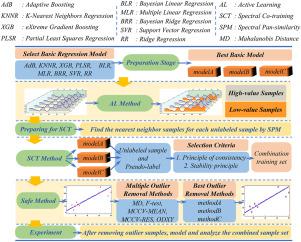当前位置:
X-MOL 学术
›
Anal. Chim. Acta
›
论文详情
Our official English website, www.x-mol.net, welcomes your feedback! (Note: you will need to create a separate account there.)
Near-infrared spectral expansion method based on active semi-supervised regression
Analytica Chimica Acta ( IF 5.7 ) Pub Date : 2024-06-19 , DOI: 10.1016/j.aca.2024.342890 Yican Huang , Zhengguang Chen , Jinming Liu
Analytica Chimica Acta ( IF 5.7 ) Pub Date : 2024-06-19 , DOI: 10.1016/j.aca.2024.342890 Yican Huang , Zhengguang Chen , Jinming Liu

|
The utilization of near-infrared (NIR) spectroscopy, in conjunction with chemometric techniques, has been widely used in a variety of sectors, including agricultural production and pharmaceutical production. Nevertheless, the laborious and arduous procedure of gathering samples and evaluating their physicochemical properties leads to relatively limited training set sizes for modeling. This problem severely limits the optimization and practical application of NIR spectrum analysis models. The Safer Active Semi-Supervised Sample Augmentation Learning Model (Safer-ASA) proposed in this paper tries to address the problem by incorporating active learning (AL) and semi-supervised learning (SSL) techniques. Experiments were conducted on two sets of publicly available NIR spectral datasets, and the Safer-ASA model was compared to other models with similar characteristics. The experimental results indicate that the Safer-ASA model proposed in our study outperforms comparable models in terms of accuracy and robustness when dealing with scenarios having a limited number of labeled samples. Furthermore, after the training set was expanded with the Safer-ASA model, the Partial least squares regression (PLSR), Bayesian ridge regression (BRR), and Support vector regression (SVR) models on the Diesel dataset improved their on the test set by 5.923 %, 3.018 %, and 7.331 %, respectively, compared to the models using only the labeled sample set. On the other hand, the Ridge regression (RR), BRR, and SVR models on the test set on the Shoot dataset improved the by 4.169 %, 4.449 %, and 11.597 %, respectively. Overall, the Safer-ASA model can effectively expand the NIR spectral dataset and considerably improve the performance of the NIR spectral analysis model. Using the AL method, the SSL method, and the co-training method together, a novel and effective method is presented for generating high-quality pseudo-labels. This method opens up new avenues for enhancing the efficiency and precision of NIR spectrum analysis. It also provides novel perspectives on sample diversification and prospective applications in other disciplines.
中文翻译:

基于主动半监督回归的近红外光谱展开方法
近红外(NIR)光谱与化学计量技术的结合已广泛应用于农业生产和药品生产等各个领域。然而,收集样本和评估其理化性质的费力和艰巨的过程导致建模的训练集大小相对有限。这一问题严重限制了近红外光谱分析模型的优化和实际应用。本文提出的更安全的主动半监督样本增强学习模型(Safer-ASA)试图通过结合主动学习(AL)和半监督学习(SSL)技术来解决这个问题。在两组公开的近红外光谱数据集上进行了实验,并将 Safer-ASA 模型与具有类似特征的其他模型进行了比较。实验结果表明,在处理标记样本数量有限的场景时,我们研究中提出的 Safer-ASA 模型在准确性和鲁棒性方面优于同类模型。此外,在使用 Safer-ASA 模型扩展训练集后,Diesel 数据集上的偏最小二乘回归 (PLSR)、贝叶斯岭回归 (BRR) 和支持向量回归 (SVR) 模型在测试集上的性能提高了与仅使用标记样本集的模型相比,分别为 5.923%、3.018% 和 7.331%。另一方面,Shoot 数据集测试集上的 Ridge 回归 (RR)、BRR 和 SVR 模型分别提高了 4.169%、4.449% 和 11.597%。总体而言,Safer-ASA模型可以有效扩展近红外光谱数据集,并显着提高近红外光谱分析模型的性能。 结合使用 AL 方法、SSL 方法和协同训练方法,提出了一种生成高质量伪标签的新颖有效的方法。该方法为提高近红外光谱分析的效率和精度开辟了新途径。它还为样本多样化和其他学科的潜在应用提供了新颖的视角。
更新日期:2024-06-19
中文翻译:

基于主动半监督回归的近红外光谱展开方法
近红外(NIR)光谱与化学计量技术的结合已广泛应用于农业生产和药品生产等各个领域。然而,收集样本和评估其理化性质的费力和艰巨的过程导致建模的训练集大小相对有限。这一问题严重限制了近红外光谱分析模型的优化和实际应用。本文提出的更安全的主动半监督样本增强学习模型(Safer-ASA)试图通过结合主动学习(AL)和半监督学习(SSL)技术来解决这个问题。在两组公开的近红外光谱数据集上进行了实验,并将 Safer-ASA 模型与具有类似特征的其他模型进行了比较。实验结果表明,在处理标记样本数量有限的场景时,我们研究中提出的 Safer-ASA 模型在准确性和鲁棒性方面优于同类模型。此外,在使用 Safer-ASA 模型扩展训练集后,Diesel 数据集上的偏最小二乘回归 (PLSR)、贝叶斯岭回归 (BRR) 和支持向量回归 (SVR) 模型在测试集上的性能提高了与仅使用标记样本集的模型相比,分别为 5.923%、3.018% 和 7.331%。另一方面,Shoot 数据集测试集上的 Ridge 回归 (RR)、BRR 和 SVR 模型分别提高了 4.169%、4.449% 和 11.597%。总体而言,Safer-ASA模型可以有效扩展近红外光谱数据集,并显着提高近红外光谱分析模型的性能。 结合使用 AL 方法、SSL 方法和协同训练方法,提出了一种生成高质量伪标签的新颖有效的方法。该方法为提高近红外光谱分析的效率和精度开辟了新途径。它还为样本多样化和其他学科的潜在应用提供了新颖的视角。






































 京公网安备 11010802027423号
京公网安备 11010802027423号